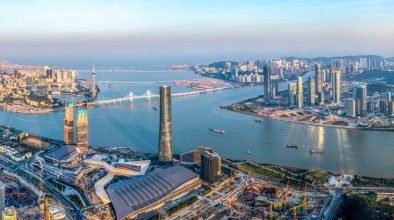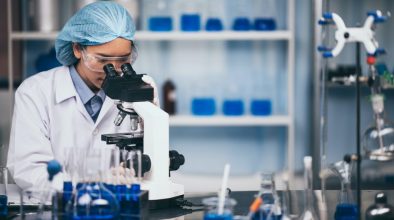TEXT Tony Chouin Lai
This year’s unveiling of the outline plan for the Guangdong-Hong Kong-Macao Greater Bay Area – and subsequent support measures – underscores China’s commitment when it comes to this important regional integration, which is years in the making.
Twenty years ago, in December 1999, there was no Greater Bay Area. The regions and cities in the Chinese province of Guangdong that now make up this zone may have physically existed but there was no big initiative in place that brought them all together with shared goals and a shared future. In February, however, that all changed. Amid high expectations across cities and industries, the Outline Development Plan for the Guangdong-Hong Kong-Macao Greater Bay Area was finally unveiled, bringing the two Special Administrative Regions and nine municipalities together for co-operation and development.
“Its main purpose is to create an economically vibrant region,” says José Luís de Sales Marques, president of the Institute of European Studies of Macao, “with innovation and high technology-based industries and services at its core. As one of the two SARs, Macao is set to play an important role.” Although China’s State Council only formulated this key strategic plan earlier this year to turn the region into one of the most robust megalopolises in the world by 2035, the idea of building this city cluster of living, working and travelling has been more than a decade in the making.
Leveraged on the strengthening ties of Macao and Hong Kong with Mainland China – particularly nearby Guangdong – since the handover of administration in both cities respectively in 1999 and 1997, the central government proposed in 2008 the ‘Outline of the Plan for the Reform and Development of the Pearl River Delta (2008-2020)’. This blueprint has gradually evolved into the GBA initiative, which was confirmed for the first time in an official document by the Chinese government in Beijing in 2015.

From the perspective of Macao lawyer Carlos Simões, who is president of the Macau European Chamber of Commerce, the integration of the three sides has been continual over the past two decades, from tourism and business to day-to-day life. “The majority of the visitors to Macao,” he says, “the life blood of Macao’s tourism economy, originates from Mainland China. Guangdong province is a major contributor to that flow of visitors to Macao.”
“Many residents in Macao already have their daily lives split across the GBA,” continues Simões. “There is an increasing number of individuals who either work in Macao and live in Mainland China or live in Macao and have to travel almost daily to the Mainland because of their businesses or jobs. Therefore, it is easy to conclude that the GBA is already a reality and not just the future.”
Mutual exchanges
The number of companies in Macao with capital from the Mainland side of the GBA was ever-increasing in the more recent years before the publication of the outline plan. According to the Statistics and Census Service, the number of enterprises incorporated in the territory with capital from the nine Guangdong cities stood at 656 last year, rising nearly 32 per cent from 497 in 2015, while the inward direct investment from this bloc to Macao expanded close to tenfold over the same time period to MOP 448 million – US$55.6 million – last year.
And this investment flow is not only one-way traffic. The same set of data also shows the amount of the city’s outward direct investment to the adjacent province amounted to MOP 11.85 billion – US$1.47 billion – last year, representing 43.6 percent of the city’s total outward direct investment.
With the outline development plan – which lays down the strategic positioning, objectives and principles of the GBA – and more supportive policies and measures from the central government, this city cluster – boasting the gross domestic product of just over RMB 10.86 trillion – MOP 12.46 trillion or US$1.55 trillion – and a population size of more than 71 million in an area of 55,910 square kilometres as of last year – will not only create more development opportunities for Macao and Hong Kong but also lead the way for the nation’s opening up.
Ties with the PSCs

Under the outline plan, Hong Kong, Macao, Guangzhou and Shenzhen are stipulated as ‘core engines for regional development’, with Macao’s role as ‘the world centre of tourism and leisure’ and a ‘commerce and trade co-operation service platform between China and Portuguese-speaking countries’. Through this initiative, the city should ‘promote the appropriate economic diversification and develop into a base for exchange and co-operation where Chinese culture is the mainstream and diverse cultures coexist’, the plan reads.
Given Macao’s historic relations with Portuguese-speaking countries through Portugal, Sales Marques believes the city could help further facilitating ties between the two sides. A multilateral, intergovernmental co-operation mechanism aimed at promoting the economic and trade exchanges between China and Portuguese-speaking countries – Forum Macao – was launched in 2003 with the permanent secretariat located in the city.
The Macao government’s recent commitment in promoting arts and culture exchanges between the two sides is also a way to go forward, alongside business and tourism co-operation, Sales Marques continues. For instance, the outline plan, he notes, mandates Macao could be a platform for financial services between China and Lusophone countries and become an RMB clearing centre for the latter.
“It is, thus,” notes Sales Marques, “in the connection between China and Portuguese-speaking countries that Macao finds its place in the meta-convergence between the construction of the GBA and the Belt and Road’ initiative.” The latter is a global development strategy tabled by the central government to enhance the connectivity among Asia, Europe, African and the Middle East through infrastructure and other investments.
Fifteen new measures
In a bid to ensure better supervision, the central government set up a leading group for the development of the GBA last year, comprising officials from Guangdong, Hong Kong and Macao, headed by China’s Vice Premier Han Zheng. This top-tier body met in Beijing in November and unveiled 15 new measures and policies to support Macao’s role in the GBA.

These new measures can be divided into two areas: benefitting the general public and supporting professional services and businesses. When it comes to the general public, measures include facilitating property purchases by Macao residents in the Mainland cities of the GBA, more convenience for non-Chinese holders of Macao IDs to stay or reside in the Mainland side of the GBA and allowing the children of Macao residents to enjoy the same standard of education as those of Mainland residents in the GBA. Another important measure is for the facilitation of travel by foreign nationals holding Hong Kong or Macao permanent resident ID cards to and from the nine Mainland cities in the GBA, as well as facilitation of a system for them to stay or reside in any of those cities.
As for supporting services, these measures include extending the scope of mutual recognition of qualifications to architects and structural engineers, loosening the restrictions for Macao interests in law firms in the Mainland and supporting the bond market development in the city. Positioning itself to grasp the opportunities arising from the GBA, Sales Marques emphasises the city should ‘strengthen its internal capacity and enhance the education, training, innovation, employment and quality of life of its population’, adding that young people in the SAR could ‘find jobs in the Greater Bay Area that Macao does not offer them today’.
Improving infrastructure
Better infrastructure is, undoubtedly, a key to expediting the flow of people in the region. “Any work made in this area would certainly substantially reduce the time needed to travel from [other cities in GBA] to Macao and vice versa,” says Simões. The authorities should optimise the performance and efficiency of existing infrastructure, he adds, citing, for instance, more ferry services being made available between Macao and Mainland cities in the GBA. This is in addition to the Hong Kong-Zhuhai-Macao Bridge – the world’s longest sea crossing bridge – which significantly reduces the land transportation time among the three destinations. The bridge has seen more than 1.53 million vehicles – or an average of 4,212 vehicles a day – and more than 24.43 million passenger trips in its first year of operation since October last year.
Not only the transportation infrastructure but also the border facilities have been ameliorated to get ready for the growing traffic in the GBA. A new border checkpoint between Macao and Guangdong – ‘Qingmao Border’ in Ilha Verde, which will open around the clock – is now being built and expected to be completed by the end of next year, in addition to the Gongbei Port, the checkpoint at the HZMB, Hengqin Port and the customs at the Cross-Border Industrial Area.
The nation’s top legislature, the Standing Committee of the National People’s Congress, also approved in October to grant the city jurisdiction over the Hengqin Port. The SAR government said in a statement after the approval that it ‘carried great significance in terms of strengthening the interconnectivity of infrastructure linking Macao and the Mainland, enhancing the convenience of boundary-crossing procedures and promoting the highly efficient and convenient flow of elements necessary for productivity, such as human talent and goods’. The government would work with the Guangdong administration to enforce the ‘Joint Inspection and One-time Release’ principle at the Hengqin checkpoint to expedite the flow of people and goods, the statement read.
Our own backyard
Hengqin, along with the Nansha Development Zone of Guangzhou, the Tsuiheng New District of Zhongshan and the Jiangmen Greater Guanhai Bay Economic Zone, has, throughout the years, been a focus of the joint development between Guangdong and Macao. These platforms do not only serve as pilot areas for bilateral co-operation but also provide more room for the city’s economic diversification.
Following the inking of the ‘Framework Agreement on Co-operation between Guangdong and Macao’ in 2011, the two sides have been committed to developing the Guangdong-Macao Industrial Co-operation Park in Hengqin, which covers an area of five square kilometres, for nurturing various sectors, namely traditional Chinese medicine, cultural and creative industries, education and professional training, including the 500,000-square metre Traditional Chinese Medicine Science and Technology Industry Park of Co-operation.
About 2.43 square kilometres of land in the Industrial Co-operation Park has been reserved for 28 projects backed by Macao capital as of this year, while the traditional Chinese medicine park had accommodated 155 enterprises, including 38 Macao firms, as of September. Even with the progress in Hengqin, which is often dubbed the ‘backyard’ of Macao, Simões highlights more thinking and better planning have to be done in regards to the nearby island to better complement the offerings in the city. “Overall,” he adds, “the GBA is a major opportunity for Macao – but one already in the making.”



